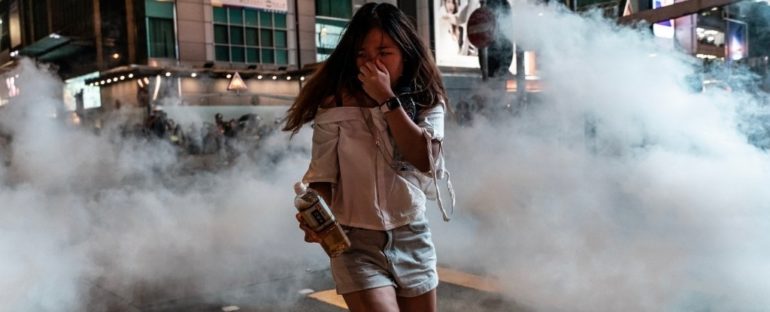The laws that govern the use of tear gas are downright illogical, argue human rights advocates.
The very same “riot control agents” recently deployed against citizens in Hong Kong, the United States, Chile, Turkey, Nepal, Greece, France, India, Lebanon and South Africa (not to mention many more) have been banned from international warfare under the Chemical Weapons Convention for decades.
A new report from researchers at the University of Toronto argues it’s high time we amend the rules – particularly as the use of tear gas could contribute to the spread of COVID-19.
These dangerous and indiscriminate gases have been abused by law enforcement for far too long, the researchers argue, and the only way to ensure citizens their freedom of speech and assembly is to put a stop to their use completely.
“While international guidance governing the use of tear gas exists, these soft law instruments have shown to be largely ineffective in constraining misuse of tear gas or in protecting fundamental rights,” says Maija Fiorante, an international human rights researcher.
“Under international law, any use of force by law-enforcement authorities must abide by the principles of necessity and proportionality, but tear gas is hardly ever used in accordance with such principles.”
The sale and trade of tear gas worldwide is largely unregulated, and as a result, it’s often not clear what chemicals exist in each canister, how toxic these chemicals are, or even whether they’ve been safety tested beforehand, the researchers explain.
One of the most popular chemical irritants is CS gas (2-chlorobenzylidene malononitrile), which is said to act like a “powdered barb“, causing a burning sensation in the eyes, throat and nose, copious coughing and crying, and restricted breathing.
As savage as that sounds on the human body, we still have very little epidemiological research on the long-term risks for those exposed.
Given the lack of data, health experts have been calling for a moratorium on the use of these “chemical batons” since the turn of the century, and yet in the years since, the production and sale of CS gas worldwide has continued to surge, becoming a billion dollar industry.
In recent years, however, there have been some worrying results published. A 2014 study from the US military found being exposed to CS tear gas just once strongly increased your chances of developing respiratory illnesses, such as influenza or bronchitis.
These are viral infections that impact the lungs, just like COVID-19, the researchers note, which means the use of tear gas right now on protesters is especially worrisome.
Tear gas also causes people to cough violently, which could further spread the coronavirus among the public.
“Tear gas is not a relatively benign method of crowd control, its deployment effectively crushes the right to freedom of protest and assembly,” says human rights lawyer Vincent Wong.
Health experts from many different fields agree. In recent months, as protests over the police killing of George Floyd have continued, police have been using tear gas routinely to control crowds.
In response, 1,288 public health professionals in the US signed an open letter in June urging law enforcement to stop the use of tear gas, smoke and other respiratory irritants, as they could increase the risk of COVID-19 transmission, while also leaving the lungs vulnerable to infection.
The president of the American Thoracic Society has also called for a moratorium on CS tear gas and OC pepper weapons, such as pepper spray, given the “lack of crucial research, the escalation of tear gas use by law enforcement, and the likelihood of compromising lung health and promoting the spread of COVID-19.”
Still, there are serious concerns about tear gas that exists above and beyond the current pandemic. The American Academy of Ophthalmology has condemned the use of tear gas and rubber bullets because when shot at close distances they can actually blind people.
Several protesters of police brutality in the US have already been blinded or received serious eye wounds from these weapons.
Direct impact is only part of the damage. Even when minimal amounts of tear gas are used outdoors, where chemicals can more easily dissipate, there could be dangerous consequences, the new report states.
Given how far and wide these tear gases can seep, the University of Toronto researchers say the use of these chemicals near hospitals and schools is particularly egregious.
In Hong Kong, whole schools and hospitals had to recently be deep cleaned and their ventilation systems replaced after tear gas seeped in from nearby.
Amid growing concerns from the American public, Planned Parenthood has begun a study on how exposure to these chemicals might impact pregnancy.
If a dose of tear gas is toxic enough, it can even lead to respiratory failure and death, and this risk goes way up when the chemical irritants are deployed in enclosed spaces. Nevertheless, tear gas is being increasingly used in prisons worldwide as a form of riot control.
Amnesty International has concluded in certain cases, the use of tear gas amounts to torture.
Some countries have stricter controls on tear gas than others, but on the whole, there is little enforcement of these rules, and the lack of international regulation means it’s pretty much up to the discretion of law enforcement.
“Although international guidance exists, including UN guidelines on the use of less-lethal weapons, these non-binding documents are vague and ineffective in curtailing violations, giving rise to a situation where tear gas is systematically prone to misuse,” the new report argues.
To avoid further transgressions, this new report joins a chorus of other voices calling for tear gas to be banned from domestic use, just as it is in international warfare.
You can read the full University of Toronto’s International Human Rights Program report here.



